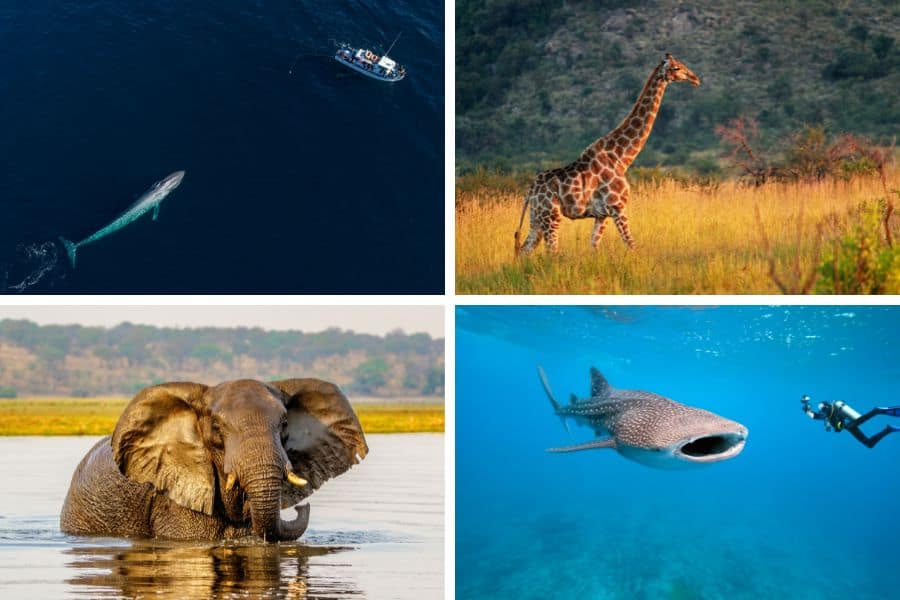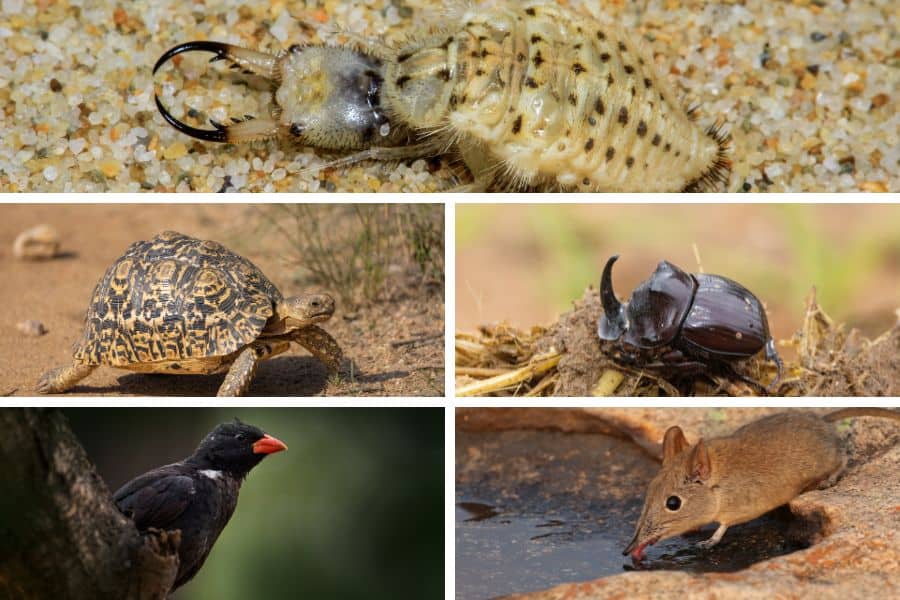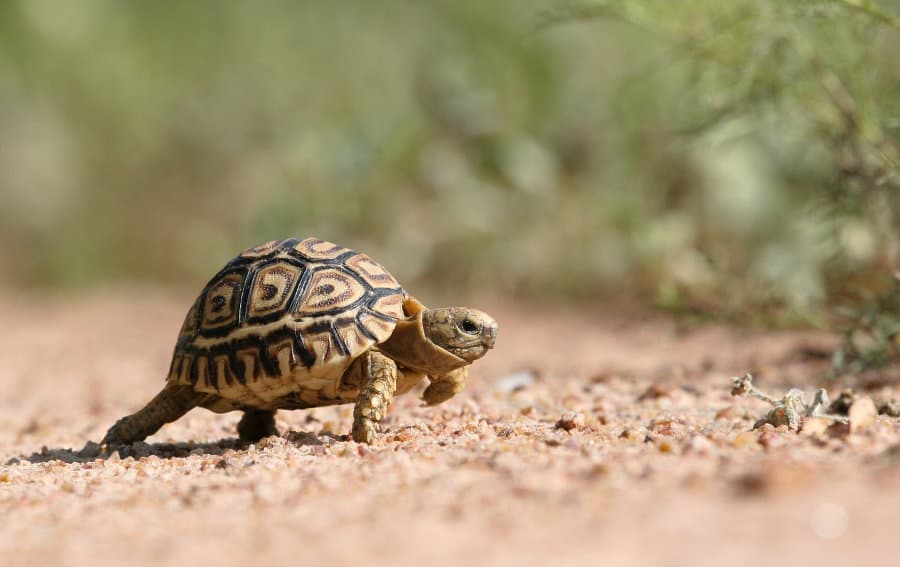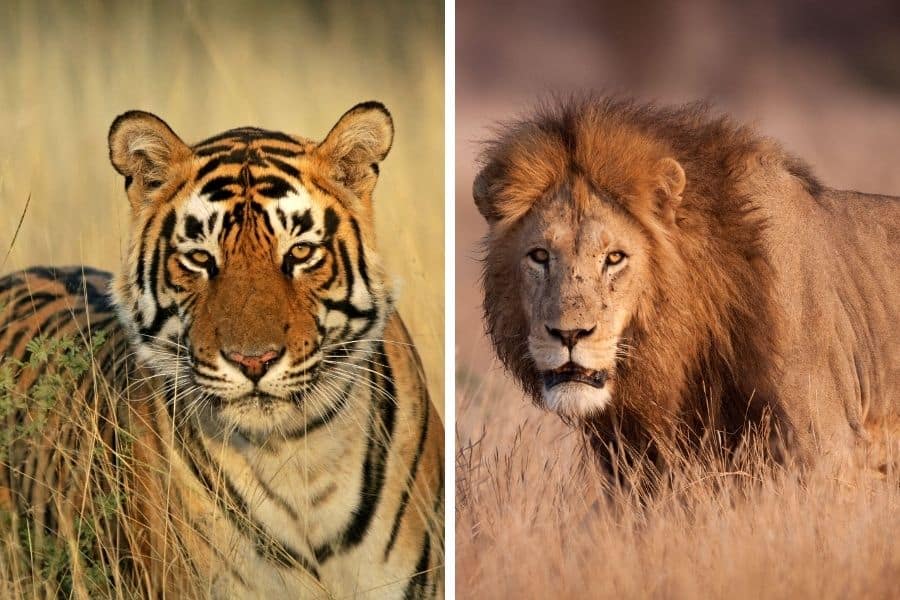Animals come in all shapes and sizes, but some are simply enormous. From massive marine mammals to lofty land animals, the world is home to a fascinating array of colossal creatures.
In this article, we’ll explore the top 10 biggest animals in the world, from the African elephant to some curious sea creatures.
We’ll delve into their weight and length and take a closer look at where each animal lives and what it eats (to get so big).
So, get ready to discover some of the giants of the animal kingdom!
What is the Biggest Animal in the World?

The blue whale (Balaenoptera musculus) is the largest animal in the world and the biggest known animal to have ever existed.
They can reach 30 meters in length and weigh up to 200 tons.
What is the biggest animal in the world on land?
The biggest land animal in the world is the African bush elephant (Loxodonta africana).
This mighty animal is native to Africa and can reach 4 meters in height and weigh up to 6 tons.
The Biggest Animals By Size
We won’t keep you waiting; here are 10 of the world’s biggest creatures, ordered by size.
Blue whale – Largest known animal in the world
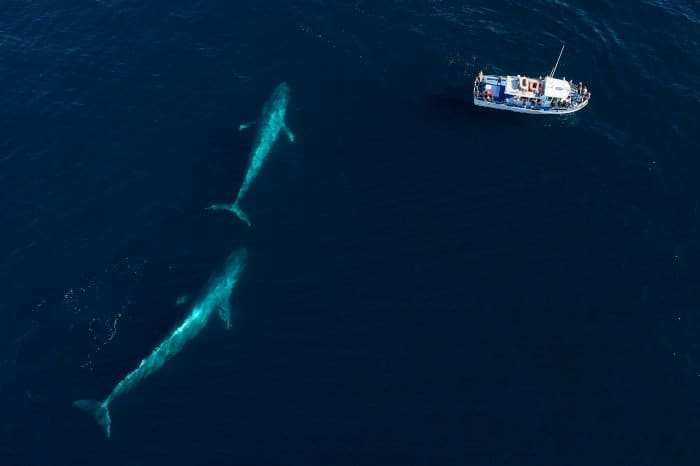
The blue whale (Balaenoptera musculus) is a marine mammal and the largest animal known to have ever existed on Earth. Yes, it is bigger than even the largest of the dinosaurs.
Their name refers to the blue-gray coloration of their skin, which can have a mottled appearance due to the build-up of microorganisms.
They can reach lengths of up to 30 meters and weigh as much as 200 tons, which is the equivalent of approximately 33 elephants. A blue whale’s tongue alone can weigh as much as an elephant!
You’d think such large animals would eat big creatures. However, blue whales feed on small crustaceans called krill instead, which they filter through their baleen plates.
Blue whales can consume up to 4-6 tons of krill in a single day.
Whale shark – The world’s largest fish
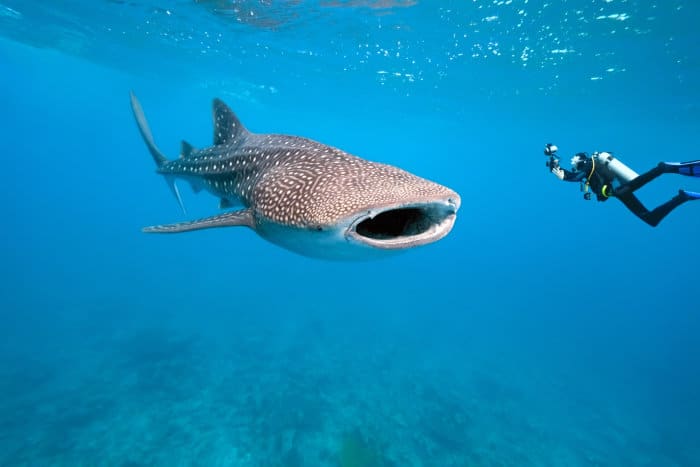
The whale shark (Rhincodon typus) is the world’s largest fish and can grow up to 18 meters in length and 14 tons in weight.
These big sharks are, however, gentle giants and filter feeders, using their large mouths to consume plankton, small fish, and crustaceans.
Whale sharks love warm waters and live in tropical areas around the world. They are capable of swimming long distances and even migrating across entire oceans, although they are slow swimmers.
These sharks tend to congregate in shallow waters along the coast and are thus a popular sight for divers and snorkelers.
They have a distinctive appearance, with a flattened head, broad snout, and spotted skin pattern. Like a fingerprint, these spots are unique to each individual. So researchers use these to identify and track them for research and conservation efforts.
Although whale sharks are not considered endangered, they are still at risk from a variety of threats. These include getting trapped in fishing nets and the demand for their fins and meat in some parts of the world.
African elephant – Largest land animal in the world
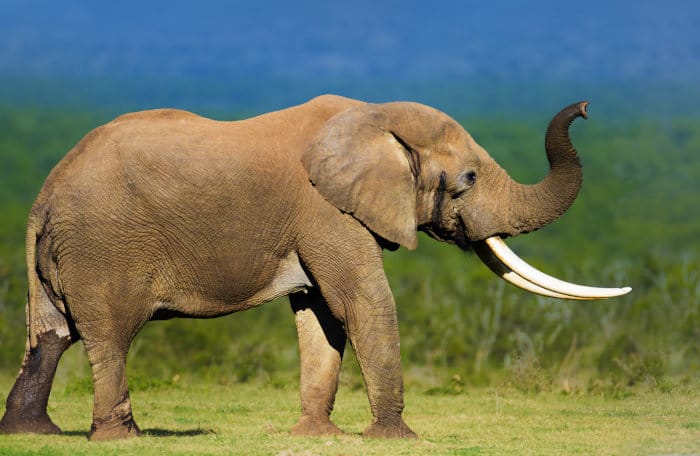
The African elephant (Loxodonta africana) is the largest land animal on Earth and, as its name suggests, is native to Africa.
They have a distinctive appearance, with large, floppy ears that resemble the shape of the African continent.
Elephants’ long, curved trunks have 40 000 muscles, which they mainly use for eating and drinking. Elephants eat up to 170 kilograms of vegetation in a single day, as they are herbivores.
How big are elephants? These mighty giants can grow up to four meters tall and weigh almost 6 tons — remember the blue whale’s tongue?
These social creatures are one of the smartest animals in the world and have strong family bonds that are critical to their survival. They live in large herds, led by a dominant female called a matriarch.
The matriarch is responsible for guiding the herd to food and water sources, as well as providing protection from predators.
African elephants communicate with each other through a variety of sounds, including trumpets, grunts, and even rumbling vibrations that can travel through the ground.
White rhinoceros

The white rhinoceros (Ceratotherium simum) is one of the two species of rhinoceros found in Africa, the other being the black rhinoceros. They are the second largest land mammal, after the elephant, and can weigh as much as 4 tons.
Despite its name, the white rhinoceros is not actually white. It is instead named after the Afrikaans word “wyd”, meaning “wide”, which refers to its square-shaped mouth.
Have you ever wondered what rhinos eat? White rhinoceros are actually herbivores.
They have interesting grazing behaviors, which involves walking with their head down and using their wide, square-shaped lips to crop grass.
Their eyesight is poor, but rhinos have a keen sense of smell, which they use to detect predators and other congeners in the area.
They are also known for their aggressive behavior and will charge at perceived threats, including humans and vehicles. This characteristic is one of the reasons why they form part of the African Big Five.
Hippopotamus

The hippopotamus (Hippopotamus amphibius) is a large, semi-aquatic mammal native to sub-Saharan Africa. They are the third-largest land animal and can weigh almost 4 tons.
Despite their sheer size, they are agile on land and in water. In fact, hippos can run up to 8 km/h underwater and up to 30 km/h on land. Above that, hippos can hold their breath for up to five minutes.
They are herbivores and spend most of their time in the water, coming out at night to graze on grass and other vegetation. Hippopotamuses have spectacular teeth, which help them chomp away at batches of grass.
They are social animals and live in groups of up to 30 individuals, with a dominant male, or bull, leading the group.
Hippos can be dangerous and aggressive towards humans, particularly when they feel threatened or someone invades their territory. So be sure to keep a safe distance.
Despite their tough exterior, these river horses have sensitive skin that is susceptible to sunburn and drying out. So they secrete a thick, pinkish liquid that acts as a natural sunscreen and moisturizer.
Hippos make distinctive sounds, which include grunts, snorts, and bellows that are audible from a mile away. So keep an ear out for them while on an African safari.
Giraffe – Tallest land animal in the world

Giraffes (Giraffa camelopardalis) are the tallest living land animals, with adult males standing up to six meters tall and weighing almost 2000 kilograms.
When it comes to fun facts about giraffes, many know about their dazzling, elongated necks.
However, did you know that they have a slow metabolism and require little water? This enables them to survive in areas with limited resources.
These large animals are native to the savannas of Africa and are well adapted to their arid environment. Giraffes are herbivores, and their long necks allow them to reach high into trees to feed on the juicy leaves and flowers that other animals cannot reach.
While many admire the giraffe’s impressive height, these animals are also graceful and swift runners. Giraffes can run up to 60 km/h. The fastest athlete on earth could only reach about 45 km/h — and they don’t even have that long neck to carry with them!
Sadly, like many other species, they are facing threats from habitat loss, poaching, and other human activities.
Their populations have declined significantly in recent years, and they are listed as a vulnerable species by the International Union for Conservation of Nature (IUCN).
Saltwater crocodile – Biggest reptile in the world
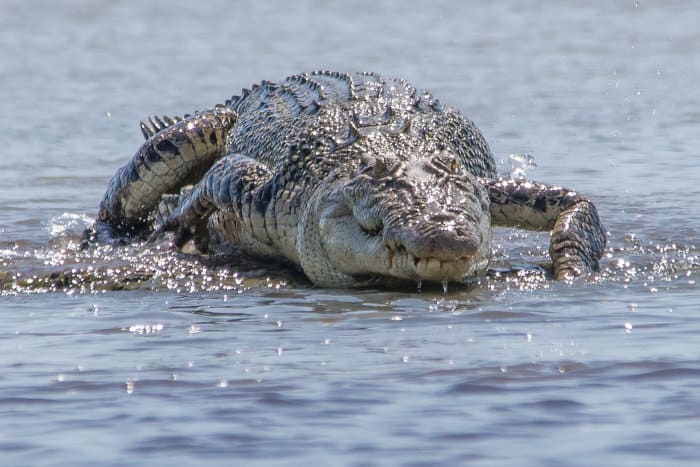
The saltwater crocodile (Crocodylus porosus) is the largest living reptile. That’s right; they even beat out Africa’s Nile crocodile.
These apex predators live in the brackish and freshwater habitats of Southeast Asia and Australia. They are well-adapted to their environment and boast a formidable size and strength.
Salties are capable of growing up to 6.5 meters in length and weighing over 1000 kilograms.
Saltwater crocodiles are opportunistic hunters and will eat almost anything that comes into their territory, including fish, birds, mammals, and even other crocodiles.
They are able to hold their breath for long periods of time and can remain underwater for up to an hour while they stalk their prey.
Polar bear

The polar bear (Ursus maritimus) is a large bear native to the Arctic regions of the world. Weighing between 350-800 kilograms, they are one of the two largest land carnivores, the other being the Kodiak bear.
Their sizes are so similar, so it’s a bit hard to pick one, but we’ve opted for this snow inhabitant.
These bears are highly adapted to their cold environment and have several physical features that allow them to survive in the harsh conditions of the Arctic.
You may think that polar bears boast a soft, fully white coat, but it is actually transparent and appears white due to the reflection of sunlight. As polar bears’ skin is black, their fur provides excellent camouflage in their snowy habitat.
They also have a thick layer of blubber that helps to insulate their bodies and keep them warm, as well as large, partially-webbed paws that make them excellent swimmers.
Above that, polar bears are skilled hunters and great at catching seals, their primary source of food.
Despite their formidable size and survival skills, polar bears face threats posed by environmental changes. With Arctic sea ice supposedly shrinking, it is more difficult for them to hunt.
Siberian tiger – The world’s biggest cat
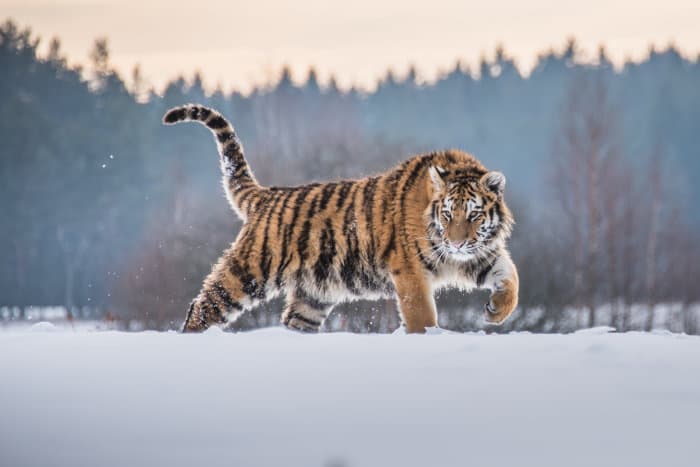
The Siberian tiger, also known as the Amur tiger, is a majestic and awe-inspiring big cat native to the cold and snowy forests of Siberia.
They are the largest subspecies of tigers in the world, with males weighing up to 300 kilograms and measuring over three meters long.
Siberian tigers have a bit of a mischievous side. They have a tendency to play with their prey, pouncing on them and chasing them around before ultimately going in for the kill.
They are also excellent swimmers, often enjoying a refreshing dip in rivers and lakes.
So, while the Siberian tiger may be a fierce and intimidating creature, it also has a playful and curious nature that makes it all the more endearing.
Ostrich – The biggest bird in the world

The common ostrich (Struthio camelus) is the largest bird in the world, native to the savannas and desert regions of Africa.
These flightless birds are well adapted to their environment, with long legs for running and streamlined bodies for efficient movement. They can weigh up to 100 kilograms and stand almost 3 meters tall.
Ostriches are omnivores. They feed on a variety of plants, insects, and small animals.
These big birds are capable of surviving for long periods without water and can obtain moisture from their food and the plants they eat.
They are important in many cultures. Their feathers and eggs have had various purposes and uses throughout history.
The eggs have served as food (they contain up to 200 grams of protein), containers, drinking vessels, and religious or symbolic items.
Which Big Animals Do You Want to See?
The animal kingdom is home to an astonishing array of creatures, including some of the largest and most impressive animals on the planet.
From the colossal blue whale to the towering giraffe, these creatures showcase the incredible diversity of life on Earth.
Whether living in the ocean or on land, these species have adapted to their unique environments in intriguing ways.
Despite their impressive size and majestic beauty, many of these animals are sadly under threat from habitat loss and other human impacts.
By learning more about these giants of the animal kingdom, we can better appreciate the natural world and work to protect it for future generations.
You may have noticed that Africa is home to many animals on this list. If you’re eager to see them in real life, why not consider booking an African safari for your next vacation?
